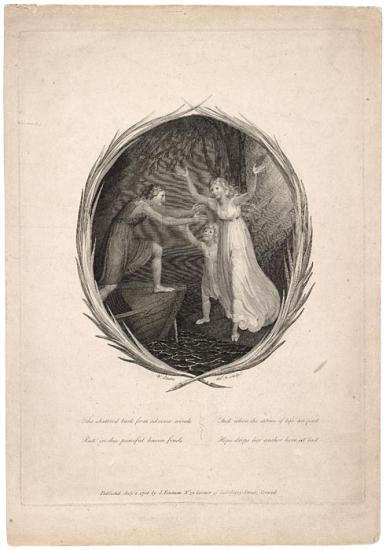
Design for the Cover Leaf of the Sheet Music An Elegy Set to Music by Thomas Commins
[London]: Published by J. Fentum, July 1, 1786
Intaglio copperplate engraving
Inscribed below image, The shatter'd bark from adverse winds / Rest in this peaceful haven finds / And when the storms of life are past / Hope drops her anchor here at last.
Gift of Charles Ryskamp in memory of Michael S. Currier
When he was about twenty-nine years old, Blake designed and engraved this cover leaf for music composed by Thomas Commins (1775–1859), the organist of Penzance, Cornwall. The stanza below the engraving is from the poem "Elegy" by Anne Home Hunter (1742–1821). The engraving depicts a returning sailor lunging into the welcoming arms of his wife and child. Only two or three copies are known.
William Blake (1757–1827) occupies a unique place in the history of Western art. His creativity included both the visual and literary arts. In his lifetime he was best known as an engraver; now he is also recognized for his innovative poetry, printmaking, and painting. Blake's keen perception of the political and social climate found expression throughout his work. His strong sense of independence is evident in the complex mythology that he constructed in response to the age of revolution.
Blake was already recognized as an engraver at age twenty-five, when his first volume of poems appeared. At thirty-three, in The Marriage of Heaven and Hell, he audaciously claimed that his birth had marked the origin of a "new heaven" in which his own art would exemplify the creativity prefigured by Milton and Michelangelo. By that time, Blake, in one of his most productive periods, had already produced Songs of Innocence and was at work on a series of illuminated books. In 1818 he met John Linnell, a young painter and engraver, through whom a group of young artists became Blake's followers. Calling themselves the Ancients, they helped perpetuate Blake's influence for generations.
The Morgan's Blake collection—one of this country's most distinguished—began with purchases as early as 1899 by Pierpont Morgan. During the tenure of Charles Ryskamp, director from 1969 to 1986, major gifts almost doubled the size of its Blake holdings. In recent years Ryskamp's own gifts of engravings, letters, and related materials have significantly enriched its scholarly resources.
I. Engravings
William Blake was tutored by his mother, given drawing lessons at the age of ten, and at fifteen apprenticed to James Basire, one of the most prominent engravers of the day. Seven years later, when the apprenticeship was complete, Blake was admitted to study at the Royal Academy. Because of this solid instruction, he was admired for his craftsmanship and often identified as "Mr. Blake, the engraver." Throughout his life, he maintained that engraving was a true art form: "Painting is Drawing on Canvas & Engraving is drawing on Copper & Nothing Else." Blake's prints demonstrate his strong commitment to line, developed through Basire and enhanced by his own creativity. Fortunately his engraver's training would support him, though not well, for the remainder of his life. At forty-six, he wrote, "I curse & bless Engraving alternately because it takes so much time & is so untractable, tho capable of such beauty & perfection."
This online exhibition is presented in conjunction with the exhibition William Blake's World: "A New Heaven Is Begun" on view September 11, 2009, through January 3, 2010.
This exhibition is made possible through the generosity of Fay and Geoffrey Elliott.
